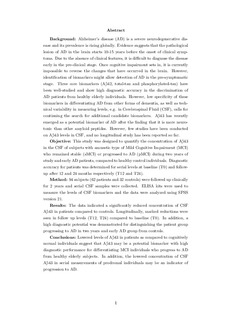| dc.description.abstract | Background: Alzheimer's disease (AD) is a severe neurodegenerative dis- ease and its prevalence is rising globally. Evidence suggests that the pathological lesion of AD in the brain starts 10-15 years before the onset of clinical symp- toms. Due to the absence of clinical features, it is diffcult to diagnose the disease early in the pre-clinical stage. Once cognitive impairment sets in, it is currently impossible to reverse the changes that have occurred in the brain. However, identi cation of biomarkers might allow detection of AD in the pre-symptomatic stage. Three core biomarkers (Ab42, total-tau and phosphorylated-tau) have been well-studied and show high diagnostic accuracy in the discrimination of AD patients from healthy elderly individuals. However, low speci city of these biomarkers in differentiating AD from other forms of dementia, as well as tech- nical variability in measuring levels, e.g. in Cerebrospinal Fluid (CSF), calls for continuing the search for additional candidate biomarkers. Ab43 has recently emerged as a potential biomarker of AD after the nding that it is more neuro- toxic than other amyloid peptides. However, few studies have been conducted on Ab43 levels in CSF, and no longitudinal study has been reported so far.
Objective: This study was designed to quantify the concentration of Ab43 in the CSF of subjects with amnestic type of Mild Cognitive Impairment (MCI) who remained stable (sMCI) or progressed to AD (pMCI) during two years of study and early AD patients, compared to healthy control individuals. Diagnostic accuracy for patients was determined for serial levels at baseline (T0) and follow- up after 12 and 24 months respectively (T12 and T24).
Method: 94 subjects (62 patients and 32 controls) were followed up clinically for 2 years and serial CSF samples were collected. ELISA kits were used to measure the levels of CSF biomarkers and the data were analyzed using SPSS version 21.
Results: The data indicated a signi cantly reduced concentration of CSF Ab43 in patients compared to controls. Longitudinally, marked reductions were seen in follow up levels (T12, T24) compared to baseline (T0). In addition, a high diagnostic potential was demonstrated for distinguishing the patient group progressing to AD in two years and early AD group from controls.
Conclusions: Lowered levels of Ab43 in patients as compared to cognitively normal individuals suggest that Ab43 may be a potential biomarker with high diagnostic performance for differentiating MCI individuals who progress to AD from healthy elderly subjects. In addition, the lowered concentration of CSF Ab43 in serial measurements of prodromal individuals may be an indicator of progression to AD. | nb_NO |
